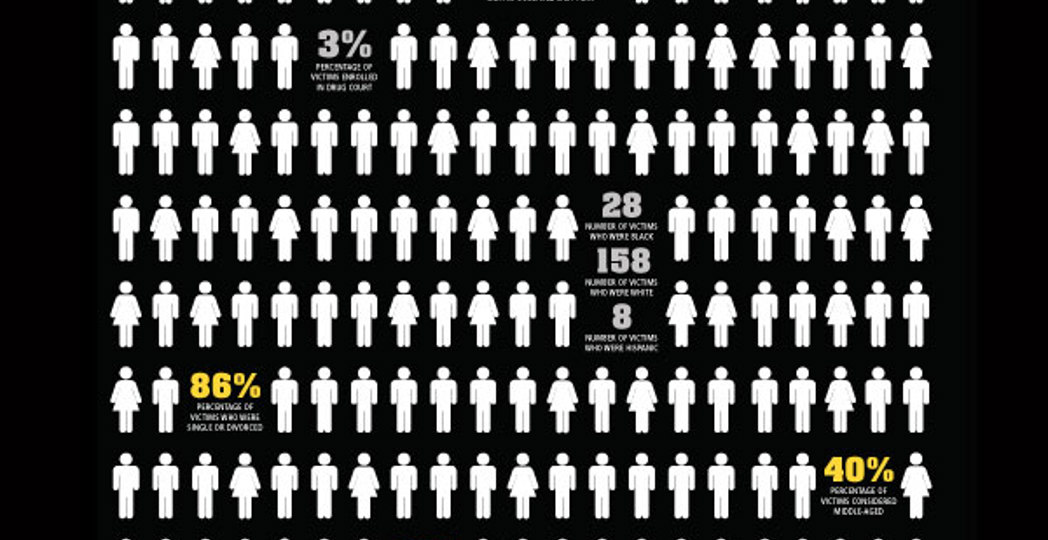194: The Heroin Epidemic
by Jillian Kramer, James Bigley II | Sep. 23, 2014 | 4:00 AM

Five seconds — one, two, three, four, five — and boom.
It's euphoric, like the release that comes after an orgasm, only stronger. Eyelids droop and limbs feel heavy. Warmth spreads from the hairline to the toes.
All it takes is one-tenth of a gram of gritty powder, pinched between a thumb and finger, and dropped onto a household spoon.
Once heroin hits the brain, the depressant acts like its parent drug, morphine. The heart slows. The person taking it relaxes and settles into the sweet sedation - the high - as the brain tells the lungs to stop breathing. That's how things can go terribly, mortally wrong.
It could take minutes, like it did for 19-year-old Lanny David Gullion III, who shot up in the bushes behind a West Side RTA station and died before he could remove the needle from his lap. Or you could fade away over hours, like 34-year-old Anthony Frank Insana, who went comatose as he rode to an emergency room, seeking treatment for a bloody cough.
But either way, you die.
In 2013, 194 people suffered fatal heroin overdoses in Cuyahoga County, a death toll up nearly 400 percent from 2007. In fact, more people died from heroin last year in the county than from homicides or suicides.
While Cuyahoga County's total number of drug overdoses are also up over the same period, the rise can be attributed almost entirely to heroin. In 2007, the drug accounted for less than 20 percent of fatal overdoses. Today, it makes up approximately 60 percent of those deaths.
"Heroin was the game changer in terms of substance abuse in Cuyahoga County," says county medical examiner Thomas Gilson. By the early 2000s, law enforcement had beat back cocaine, the drug of choice in Cuyahoga County in the •90s. But an increase in heroin production soon overtook their success. So did a crackdown on prescription painkillers, in which officers seized medications and boards revoked medical licenses. "We had this perfect storm," Gilson describes.
People with painkiller addictions often turn to heroin, the illicit cousin to prescription opiates such as codeine, methadone and oxycodone.
According to county records, 73 percent of the men and women who died last year of heroin overdoses had been prescribed a painkiller by one or more doctors.
Twenty-three-year-old Melissa Rae Koppel, for example, used heroin to curb everyday migraines when her opiate prescription supply dried up.
"You don't just show up on a corner and start shooting heroin," says Cuyahoga County sheriff Frank Bova. "You work your way up to heroin."
Afghanistan and Mexico are the largest suppliers of the drug. Culled from poppy plants, the primarily powdered substance can be snorted, smoked or injected. Smuggled across the border, it's sold on Cuyahoga County streets for just $20 a hit, less than half of the black-market cost of prescription painkillers.
"This is not a problem that is limited to our area," says Gilson. Heroin use is up nationally, with 156,000 adults trying it for the first time in 2012, double the number who did so in 2006, according to the National Survey on Drug Use and Health. Nearly 700,000 Americans are believed to have used heroin last year.
Local officials launched a countywide heroin initiative that includes a Let's Face It marketing campaign. Stretched across city billboards and buses, it encourages addicts and their families to seek help through crisis hotlines and charities.
Authorities are working with area hospitals to reduce the number of opiate prescriptions. Law enforcement task forces are now equipped with Naloxone, an opiate antagonist that can reverse an overdose in progress.
In fall 2013, federal and local officials indicted 92 people in a heroin bust, Operation Fox Hound. The two-year effort squashed a conspiracy that allegedly transported heroin from Atlanta and Chicago to Cleveland. At least five people were charged in connection with two 2013 heroin deaths. Charges included reckless homicide, manslaughter and corrupting another with drugs.
These efforts are paying off slowly. In the first half of 2014, heroin-related deaths are down 7 percent from the same period last year. But there's much left to do.
"It doesn't matter what social or economic background you have or where you live in the city," Bova says. "It's touching everyone."
The youngest was 19. The oldest was 70. They died in every month, some on the same day.
Each story is different, but they are all unified in emptiness. Loss. For those left behind, it's a mix of unanswered questions, shame, guilt and anger. Others simply can't stop crying.
These stories show you the face of heroin in Cuyahoga County and the pain the drug has left in its wake.
Their Stories: Heroin's toll extends far beyond statistics. It infects communities and devastates families. Here are the stories of those lost.










